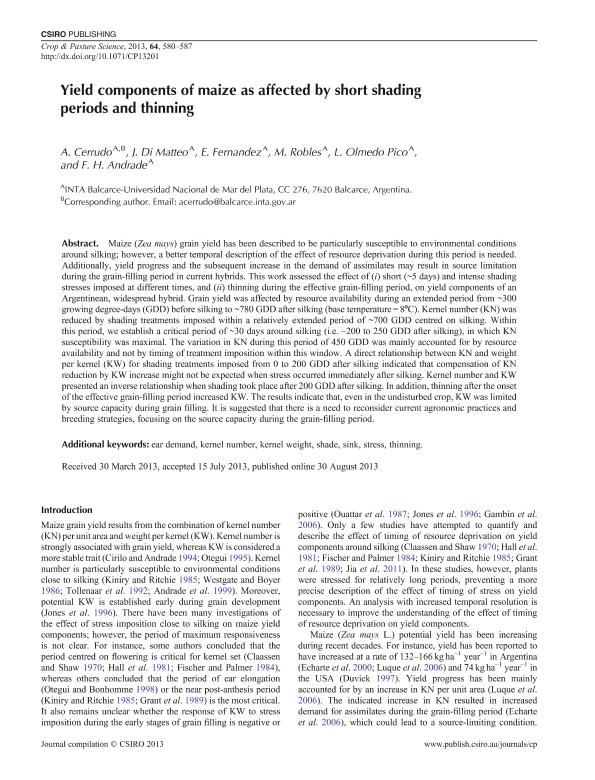Mostrar el registro sencillo del ítem
dc.contributor.author
Cerrudo, Anibal Alejandro

dc.contributor.author
Di Matteo, Javier Antonio

dc.contributor.author
Fernandez, Ezequiel
dc.contributor.author
Robles, Mariana

dc.contributor.author
Olmedo Pico, Lia
dc.contributor.author
Andrade, Fernando Héctor

dc.date.available
2017-09-28T19:08:32Z
dc.date.issued
2013-10
dc.identifier.citation
Cerrudo, Anibal Alejandro; Di Matteo, Javier Antonio; Fernandez, Ezequiel; Robles, Mariana; Olmedo Pico, Lia; et al.; Yield components of maize as affected by short shading periods and thinning; Csiro Publishing; Crop & Pasture Science; 64; 6; 10-2013; 580-587
dc.identifier.issn
1836-5795
dc.identifier.uri
http://hdl.handle.net/11336/25337
dc.description.abstract
Maize (Zea mays) grain yield has been described to be particularly susceptible to environmental conditions around silking; however, a better temporal description of the effect of resource deprivation during this period is needed. Additionally, yield progress and the subsequent increase in the demand of assimilates may result in source limitation during the grain-filling period in current hybrids. This work assessed the effect of (i) short (~5 days) and intense shading stresses imposed at different times, and (ii) thinning during the effective grain-filling period, on yield components of an Argentinean, widespread hybrid. Grain yield was affected by resource availability during an extended period from ~300 growing degree-days (GDD) before silking to ~780 GDD after silking (base temperature = 8°C). Kernel number (KN) was reduced by shading treatments imposed within a relatively extended period of ~700 GDD centred on silking. Within this period, we establish a critical period of ~30 days around silking (i.e. –200 to 250 GDD after silking), in which KN susceptibility was maximal. The variation in KN during this period of 450 GDD was mainly accounted for by resource availability and not by timing of treatment imposition within this window. A direct relationship between KN and weight per kernel (KW) for shading treatments imposed from 0 to 200 GDD after silking indicated that compensation of KN reduction by KW increase might not be expected when stress occurred immediately after silking. Kernel number and KW presented an inverse relationship when shading took place after 200 GDD after silking. In addition, thinning after the onset of the effective grain-filling period increased KW. The results indicate that, even in the undisturbed crop, KW was limited by source capacity during grain filling. It is suggested that there is a need to reconsider current agronomic practices and breeding strategies, focusing on the source capacity during the grain-filling period.
dc.format
application/pdf
dc.language.iso
eng
dc.publisher
Csiro Publishing

dc.rights
info:eu-repo/semantics/openAccess
dc.rights.uri
https://creativecommons.org/licenses/by-nc-sa/2.5/ar/
dc.subject
Ear Demand
dc.subject
Kernel Number
dc.subject
Kernel Weight
dc.subject
Shade
dc.subject
Sink
dc.subject
Stress
dc.subject
Thinning
dc.subject.classification
Otras Agricultura, Silvicultura y Pesca

dc.subject.classification
Agricultura, Silvicultura y Pesca

dc.subject.classification
CIENCIAS AGRÍCOLAS

dc.title
Yield components of maize as affected by short shading periods and thinning
dc.type
info:eu-repo/semantics/article
dc.type
info:ar-repo/semantics/artículo
dc.type
info:eu-repo/semantics/publishedVersion
dc.date.updated
2017-09-27T15:37:22Z
dc.journal.volume
64
dc.journal.number
6
dc.journal.pagination
580-587
dc.journal.pais
Australia

dc.journal.ciudad
Collingwood
dc.description.fil
Fil: Cerrudo, Anibal Alejandro. Instituto Nacional de Tecnología Agropecuaria; Argentina. Universidad Nacional de Mar del Plata; Argentina
dc.description.fil
Fil: Di Matteo, Javier Antonio. Instituto Nacional de Tecnología Agropecuaria; Argentina. Universidad Nacional de Mar del Plata; Argentina
dc.description.fil
Fil: Fernandez, Ezequiel. Instituto Nacional de Tecnología Agropecuaria; Argentina. Universidad Nacional de Mar del Plata; Argentina
dc.description.fil
Fil: Robles, Mariana. Instituto Nacional de Tecnología Agropecuaria; Argentina. Universidad Nacional de Mar del Plata; Argentina
dc.description.fil
Fil: Olmedo Pico, Lia. Instituto Nacional de Tecnología Agropecuaria; Argentina. Universidad Nacional de Mar del Plata; Argentina
dc.description.fil
Fil: Andrade, Fernando Héctor. Instituto Nacional de Tecnología Agropecuaria; Argentina. Universidad Nacional de Mar del Plata; Argentina. Consejo Nacional de Investigaciones Científicas y Técnicas; Argentina
dc.journal.title
Crop & Pasture Science

dc.relation.alternativeid
info:eu-repo/semantics/altIdentifier/doi/http://dx.doi.org/10.1071/CP13201
dc.relation.alternativeid
info:eu-repo/semantics/altIdentifier/url/http://www.publish.csiro.au/CP/CP13201
Archivos asociados
